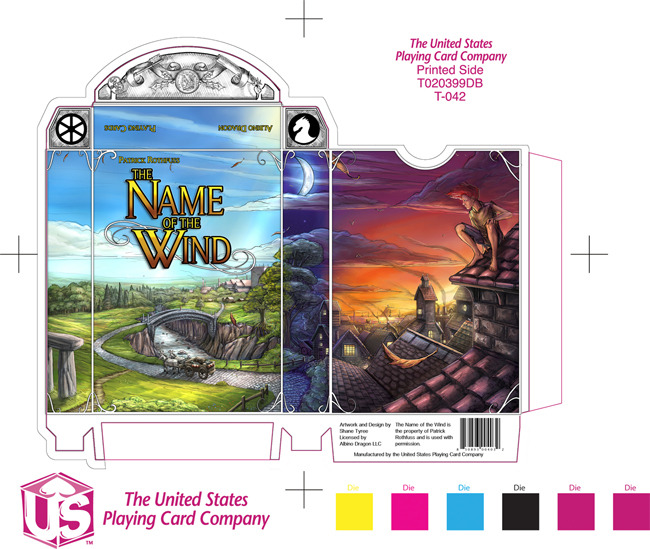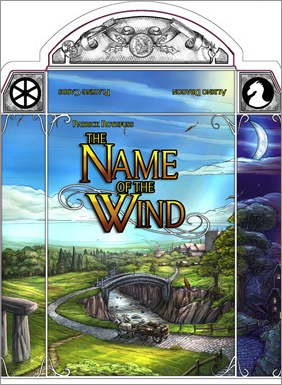My obsessively detailed reread of Patrick Rothfuss’s Kingkiller Chronicles is over, but we want to keep on talking about the books. I’m going to post the occasional continuation post when the last one gets too long or if there’s something to say.
Spoilers for all of The Wise Man’s Fear and The Name of the Wind—these discussions assume you’ve read all of both books, and frankly they won’t make the slightest bit of sense if you haven’t. But we welcome new people who have read the books and want to geek out about them. This post is full of spoilers, please don’t venture beyond the cut unless you want them.
This time, we’re going to start talking about the Name of the Wind playing cards.
Abbreviations: NW = The Name of the Wind. WMF = The Wise Man’s Fear. D3 = Day Three, the forthcoming final volume. K = Kvothe or Kote when I can’t figure out what to call him and I’m feeling Kafkaesque. MT: Myr Tariniel. D = Denna, 4C = Four Corners, CTH—that thing I can’t spell! IID3Y = Is it Day Three Yet?
Useful links: The Sleeping Under the Wagon post. The reread index. The map. The timeline. Imaginary Linguistics.
Pat Rothfuss was deeply involved with Albino Dragon’s Kickstarter for the NW playing cards, and I mentioned it here at the time and I know a lot of us backed it. It was immensely successful, and now cards have been sent out, and I have mine. I just have the basic limited edition deck, without any of the additions. I’m sure some of you have all the bells and whistles, and feel free to comment on them!
I think we can consider that these cards are canonical, considering how involved Pat was in their creation.
Firstly, they’re beautiful things, with lovely drawings by Shane Tyree.
Secondly, when I looked at them I found that either I could instantly tell who and what they were, or I was completely puzzled. There wasn’t anything where I slowly figured out what something was supposed to be, it was either instant or I an still full of questions. I think that says something—not sure if it’s about the cards or about me!
And now, let’s start our over analysis with an entire post about the box, to be followed in succeeding weeks with posts about the cards themselves.

The box first—the cover painting is of a single wagon on a road that curves towards a stone arched bridge across a river, with a stone town in the distance. There are trees and green grass and clouds in the sky—it’s a very pastoral image. The rode is cobbled, and not crazy-cobbled but flat cobbled, to make a proper smooth surface. This is a stone road if ever there was one. Is it the road to Tinue? Could be. The town as we see it has one tower and lots of slate-roofed houses. (I’m saying slate because they’re grey, tiles are usually reddish.) The road is definitely going to the town, over the arch of the bridge, and so is the wagon.
There are no human figures, and I think that’s significant. There must be somebody driving the wagon, but I can’t see them. The wagon is drawn by two white horses. This means it is not Carter’s cart—Carter had one horse, which the scrael killed. It’s also a single wagon and not a whole troupe. Nor is it Ben’s wagon—it isn’t a caravan, it’s a cart, like a horse-era equivalent of a pickup, with a flat bed covered in items. I can see bundles of various kinds and a single chest—could it be the thrice-locked chest? Could this be Kvothe coming to Newarre?
The river doesn’t seem very wide or deep, there are visible stones in it. Yet it has this very impressive bridge, with a definite stone arch. It’s not the bridge between Imre and the University, it isn’t a high arch and this is farmland. But I suppose it might be anyway, because that tower could be the Archives, maybe? I don’t know. It doesn’t feel like the University to me, it doesn’t feel arcane at all.
Earth is visible all around—in the little escarpment at the side of the river, the rocks in the river, and underlying all the green pastoral quiet countryside.
The wind is represented by the swirls on the letters of the word “wind” in the title, and by one red leaf—the only red thing in the picture—drifting downwards. The trees don’t seem to be moving and the clouds seem fairly static too. It’s not obvious where the red leaf is coming from—it’s above the tops of the trees we can see, which are all green and summery while it is red and autumnal. And the red leaf, together with the flame-coloured letters of the words, are all we have for fire, or Kvothe… unless you count the fact that it’s evidently a sunny day.
Also, the perspective is such that we’re looking slightly downwards at all this, as if we’re on an elevation.
Overanalysis is what we do here, and yet, this is just the front of the box!
On one side, we can see, looking down from the top, blue sky, a white cumulus cloud, green trees, green grass, and a grey waystone! It’s a sarcen, a menhir with a flat lintel, like Stonehenge, or like the stone Kvothe and Denna climb up onto when the draccus comes. This is clearly part of the same picture as the wagon, bridge and etc, but it’s mysteriously hidden around the corner of the box. It’s hard to assess how tall it is, because it’s up a little rise, and there is perspective, but it’s at least twice the size of the wagon. If those are big horses, it’s probably more than ten feet tall.
This connects to the front, but not at all to the back.
On the back of the box, we have fire—it’s all reds. Red-headed Kvothe is on the top of a roof, in a sea of rooftops lit by a distant sunset while another red leaf floats by. These are slates too, but tinged red by the light. This has to be Tarbean, and a leggy young boy Kvothe looking down from his perch. Water is represented by the distant river, into which the sun is sinking, and on which there are ships. Wind can be seen in the leaf, in the smoke trails which are visibly trending southwards, and in the dark clouds, also clearly moving here. It’s earth that’s missing—we’re high above it and everything in sight but river and sky is man-made. And here we’re looking up at the roof, and at Kvothe on the top.
(See what I mean? Instant recognition of the scene, unlike the front.)
A word about the leaf. It’s bigger here, and at a different angle, but clearly the same leaf. Anyone have any idea what kind of tree it’s from? It’s red (for Kvothe?) and it clearly connects to the leaves in the courtyard and all of that—what else?
The other side is the most interesting of all. It’s a twilight scene that seems to connect to both front and back.
Again looking down the stripe, there’s the moon. And behind the moon there are clouds. Behind it! I mean that! There’s a crescent moon, and we can clearly see clouds behind it, straight across behind it, as if that crescent is all that’s there and blocking just a stripe of cloud. Also, it’s between us and the clouds. That’s different and fantastical and interesting! I’d regard it as well worth my $11 (plus shipping to Canada) just for this image of the moon. Seriously. Even if clouds could be behind the moon, if the moon were inside the atmosphere, they’d go behind the whole circle of the moon even when we can only see a crescent. But here, the crescent is all that’s in whatever world we’re looking at, and the rest is in the other world. And that’s so cool!
Below this amazing moon there’s a twilight sky, there’s a hill, there are trees, there are houses which seem to connect to Tarbean on the back, and trees and slopes which seem to connect to the pastoral scene on the front. The stone road is there, joining on, and the wooden fence. This is very clever.
It’s a twilight transition phase, with the moon. Is it Fae? Is it an allegorical representation of the Faem realm? Is it the bit where Felurian lives? Is it just a bit of somewhere in twilight—after all, we don’t see Fae, or even the moon being weird, in NW, not until WMF.
It’s reasonable to see the pastoral and Tarbean as opposites in many ways—opposite sides of the box, countryside vs city, day vs night, light vs dark, man-made vs natural, with a figure vs without, angled up vs down.
So how about the two narrow sides? One has sunlight and a waystone, the other has the moon and a road, a house with lit windows. Could it be the Waystone? The inn? It totally could, but then again, maybe not. The wagon is going away from it. It’s twilight and liminal and maybe what’s opposed is the moon and the stone.
I’m not done—the box also has a top and a bottom! On the top is blue sky and clouds with manufacturing information about Albino dragon. There are three flaps. On the big flap is an awesome black and white swag, with a coin with a wreathed head, holly leaves, a key and a candle. Coin, key, candle—sounding familiar? On the two little flaps are two more black and white bits—a white cameo dragon (draccus?) head, in a black circle (could it be Albino Dragon’s albinio dragon?), and an eight spoked wheel. The bottom just has manufacturing info, and it’s glued down, and I don’t quite believe there’d be a clue if I took the box apart, and besides, I’d have nowhere to keep the cards if I did that.
Next week, spades and hearts, and then the week after clubs and diamonds!
Jo Walton is a science fiction and fantasy writer. She’s published three poetry collections and nine novels, including the Hugo and Nebula winning Among Others. She has just published a collection of her Tor.com posts, What Makes This Book So Great. She has a new novel My Real Children coming out in May. She reads a lot, and blogs about it here irregularly. She comes from Wales but lives in Montreal where the food and books are more varied.










